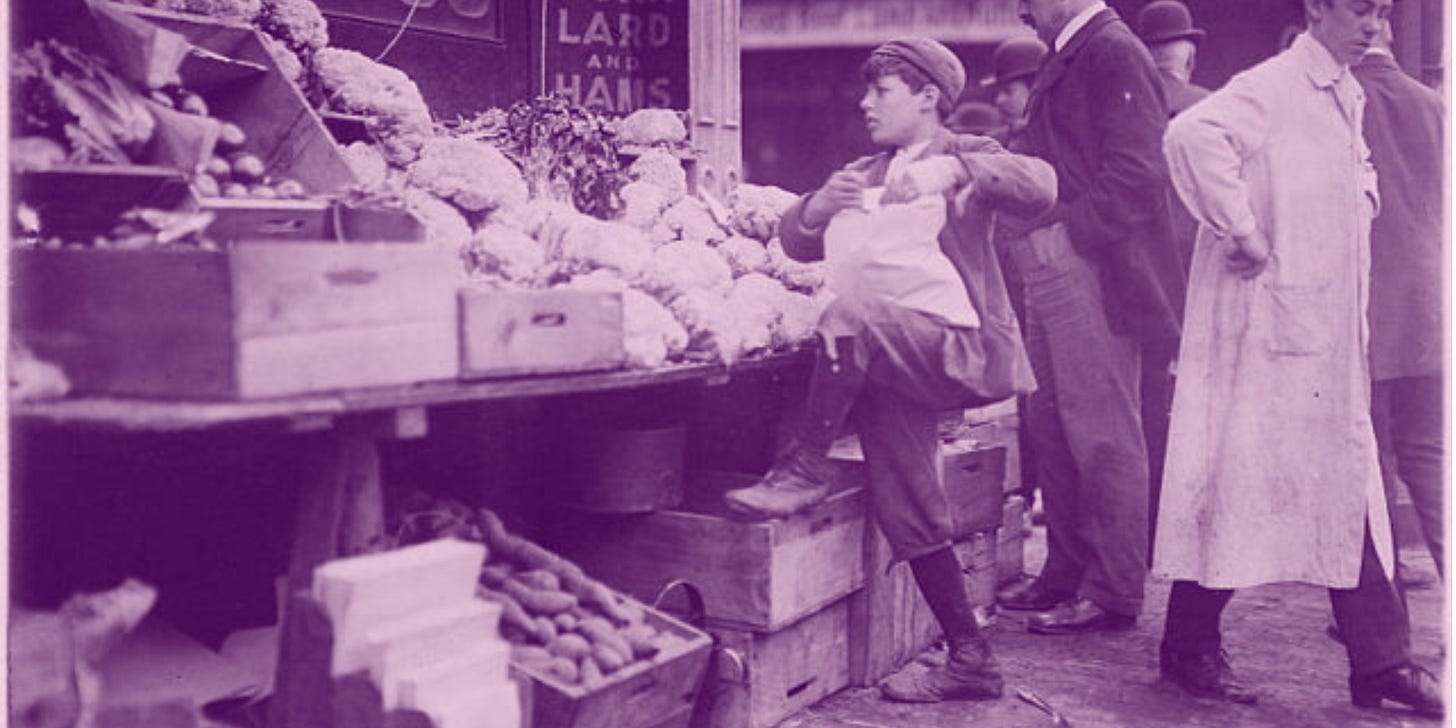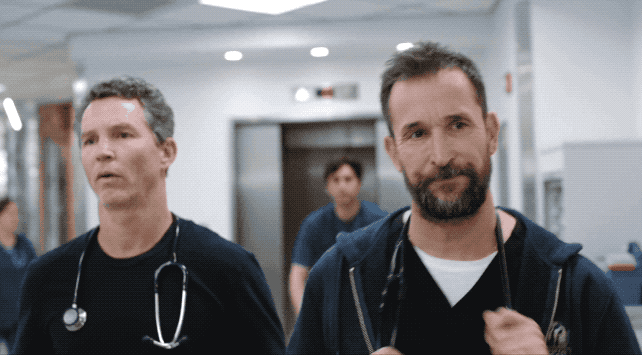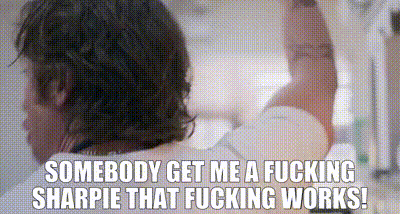
We’re a little understaffed in my shop these days (on purpose so I can develop a cash buffer by saving on payroll) and that means sometimes I’m working full retail shifts, 8–9 hours, often by myself.
I’ve been running this shop for 6 years now. When I started, I wasn’t thinking about ergonomics. Now, after averaging 7,000 steps per day (the U.S. average is 4,774) for over half a decade, working several 8-hour shifts back-to-back on my feet is becoming a thing I have to think about. We already have shock-absorbing mats. I wear prescription inserts. I’m in good shape—I do cardio! yoga! strength work!—but the physical demands of this job—lifting 50-pound bags of potting mix, unpacking pallets of heavy ceramics, heaving out trash, and generally just standing up making bouquets, washing vases, and ringing up customers—wears on the body in a way working out at the gym does not, and can’t protect against.
I turned 45 a month ago, and for the first time I can remember, the usual joint stiffness caused by a day working on my feet lasted fully into the next day. It’s beginning to dawn on me that maybe I shouldn’t keep doing the physical side of this job for another 5 years.
But is the wear and tear really that bad for me? These are the kinds of aches and pains that two ibuprofen can easily keep at bay. I’m frankly surprised that it’s standing at work that’s causing me to feel my age, not running 8 miles a week. Isn’t running more high impact?
What’s surprising to me is that when I searched the web, I didn’t find great content about the cumulative impact physical jobs have on people over 40. Yes, there’s information out there, but not content. Where are all the books, podcasts, and YouTube channels? I couldn’t even find a yoga video for people who work on their feet all day.
Then I remembered, oh yes, I’ve read Nickel and Dimed! Labor is supposed to be invisible! If you’re performing labor, it should be temporary, just until you get a better gig. Of course Adriene isn’t going to make a yoga video for laborers. Get a (standing) desk job, dummies!
Maybe it’s not accurate to lump business owners in with hourly wage workers when it comes to physical labor. Business owners have a foreseeable end to doing the work ourselves. Once you generate enough revenue, you can hire someone with juicier cartilage to do it for you. Or can you?
Main Street America just released their Spring, 2025 survey results*, and they highlight some staggering realities about small businesses. More than half (54%) the respondents reported generating less than $200,000 in annual revenue, and 53% reported their family and friends sometimes or regularly work in their businesses for free.
To add to that, 65% of business owners in the survey said they either do not or only sometimes earn an income from their business sufficient to cover basic living expenses in their area.
How can business owners ever expect to free themselves from physical labor if they can’t earn enough to pay themselves?
It’s not just the physical demands, either. Consider the cognitive strain of having to not just do the work, but manage it—and everyone else doing it, too. It’s hard to run payroll when you’re standing over a deep fryer, yet that’s what many of us are doing every day. We’re lifting, hoisting, stacking, balancing and shoving—all while absorbing detailed logistical information, facilitating high-touch customer interactions, or having delicate conversations. We are literally doing it all, physically and mentally, every day. Did anyone else watch the HBO show emergency room drama The Pitt and think, “That’s me!”?
I may not be saving lives, but I do know what it’s like to have to shift focus every 6 minutes, to have to maintain not just clarity, but composure, despite the accumulated cognitive strain of nonstop context switching paired with constant low-grade physical strain.
You think I’m exaggerating? If you want a reminder that small business life can be just as relentless as any medical drama, watch how Carmy reacts when his Sharpie stops working mid-shift during a dinner rush on The Bear, or the escalating panic that grips Howie in Uncut Gems when he can’t unlock a showroom door for a high profile client. While such drama may seem absurd to an outsider, when you remember that many of us are going unpaid, shouldering massive debt, and are a few bad sales days away from running completely out of cash, is it any wonder any of us freak out about a marker?
But are we just being too much? Unlike the subjects in Barbara Ehrenreich’s book, small business owners chose this life, it wasn’t assigned to us when we ran out of other options. We are, by all accounts, living the dream! We are our own bosses, free to say when we do and don’t work. If we don’t like it, we can just quit, right?
Many of us got into this work because we love it. We didn’t plan to ever stop. This was the dream, at one point.
After years of physical and mental strain, we might be rethinking that. That doesn’t mean we necessarily close the business, maybe just that we step back. But to do that, we need money to pay someone else to do our jobs, and often that money isn’t there. If we aren’t paying ourselves a livable wage, how can we pay someone else that? We could sell the business, but in order to find an interested buyer, we need to remove ourselves from the equation to make the business more turnkey, with less owner involvement. (No one wants to buy a business they have to actually work in. That would be considered a job, not an asset.)
If we’ve made it this far as shopkeepers, we’re probably just assuming we’ll do it forever. What other option is there? But even if we started this work healthy (let’s not even get into the barriers to launching a business if you have chronic pain, chronic illness, disability, or are managing health concerns that require consistent health coverage), no one is immune to the physiological changes that occur as we enter midlife. You start to lose muscle and bone density and your cartilage wears out. It isn’t a vanity thing to push through this inevitable decline, it’s absurd to think you can avoid it.
It turns out that standing all day amplifies these changes, and without built-in recovery days, micro-traumas accumulate—and that can lead to chronic pain and limited mobility.
That much I *could* gather from the information available on the web. If you’re not feeling it now, you will. So what’s the plan for those of us who can’t afford to spend time or money on self-care?
Clearly we need to be thinking more about exit strategies and retirement plans that are real and achievable for small business owners. How do we make concrete plans to dial back the physical work and transition to roles as mentors and leaders as we age? How do we get ourselves to a place where we do the work because we love it, not because we can’t afford to pay someone else to do it?
Honestly, I don’t know. I just know that it can’t be ignored.
Have thoughts about how to step back or retire when you run a small business?
* You may remember my post about Main Street not asking the right questions. Those two pieces of data, about free family labor and basic living expenses, came directly from my suggestions about how to ask business owners questions that get to the heart of what’s really going on here. I’m so glad they were included! The survey results are a little dismal, but at least they’re uncovering new truths that edge closer to identifying deeper, systemic issues hindering Main Street businesses.
Speaking of surveys, if you own a retail business, please take my friend Caroline Weaver’s survey at TheShopSurvey.com. Caroline runs the Locavore Guide and, like me, is on a mission to find out what’s going on with independent retail in America. Please help collect data points by taking her extremely well thought out survey!






I’m 66. My fabric store, like your business, is labor-heavy and physically intensive. Pre-Covid, I had successfully pulled back from the day-to-day operations of “working on the floor.” The last few years have required I roll my sleeves up and throw myself back into the work. I am currently struggling to pull back -recognizing how important my efforts are to the bottom line and actual survival of the business. It makes me heartsick to think I built this amazing community and may have to allow it to go away, so I can live a stronger life.
I owned/managed my store for 12 years and it's been two years since we closed, for many reasons but wanting to save my physical and mental health were on that list for sure. In addition to regular 8-10 hour days of standing, running, kneeling, and lifting, plus the mental load of customer service and being in charge of basically every part of maintaining and developing the business, its easy now to see that I never had/made the time to step back far enough to see that it was time to get out. Those Covid-era grants made things easier at the time, but they stretched out the last few years probably past what was a solid effort towards overall profitability for about a decade.
If I could go back in time, I would tell myself to hire a business coach, start saying "NO" to more things, and LISTEN to my financial advisors instead of being so sure that I was the one who could do the thing! I will never get back those last few years of abysmal pay + even more hours + wear + tear on my body. My overuse in the store plus inability to say "no" to helping a disabled family member with their homecare eventually led to a "knee sprain" which was actually a severe meniscus tear that was operated on about four years after the initial injury. This means that at age 44 I have ~10 years until a full knee replacement.
It may seem like there isn't any solution, but there is! It just isn't something you can fix immediately. Start saying "no" to some thing that are draining and "yes" to a small change that helps your physical or mental health, like closing two hours earlier when you are working alone, or hiring someone specifically to move heavy things.